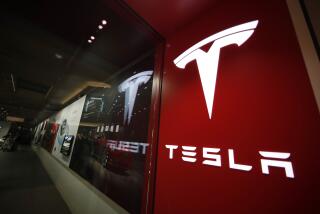Car Sales Fly on Wings of Cheap Fares : Autos: The huge demand for discount airline tickets prompts rental car companies to boost orders in late June.
Discount air fares helped drive sales of domestically built cars up 14.7% in the last 10 days of June over the same period a year earlier, as rental car companies scrambled to fill their lots to meet the demands of summer vacationers taking advantage of recent low ticket prices.
But while bulk orders from fleet customers accounted for most of last month’s sales spike, industry analysts say the increase reflects a continued gradual increase in consumer demand as well.
Truck sales for the whole month--which are a better gauge of retail demand since they are not generally sold in high volumes to fleets--climbed a healthy 18% over last June, while total vehicle sales for the month jumped 5.7%.
“In all, it’s pretty encouraging news,” said David Garrity, an analyst at McDonald & Co., a Cleveland-based investment consulting firm. “Despite all the debate on the passenger car side, light trucks give an unequivocal signal of a pretty decent economy, at least in the automotive area.”
It is the lack of corresponding strength in other areas, however, that has auto dealers wondering whether even the auto industry’s slow recovery can be sustained.
Dealers and auto executives say last week’s move by the Federal Reserve to lower the discount rate may make it easier for shoppers to get an auto loan, but the 7.8% national unemployment rate that prompted it could offset any potential benefit.
Jim Hanke, marketing manager at Worthington Ford in Long Beach, says lower interest rates have not helped aerospace industry employees in his area buy a car.
“Banks are not even looking at people from McDonnell Douglas because of the probability over the long term of them getting laid off,” Hanke said.
But for now, auto makers and dealers are hoping that strong auto sales will fuel production and help to pull the rest of the nation out of its persistent doldrums.
With another protectionist trade bill pending in Congress, several Japanese auto makers took pains to point out their contributions to the U.S. manufacturing recovery in this round of sales reports, highlighting the percentage of their vehicles built in North America.
Toyota, for example, said 46% of its June sales were vehicles built in North America, up from 36% last June. Honda noted that “approximately 87%--34,675 units--of the Accord automobiles sold last month were manufactured in the United States.”
Together, Japanese sales of imported vehicles were down 1.7% compared to last June.
The Big Three sold about 20,000 imported and 912,000 domestic vehicles in June, while the Japanese auto makers sold about 155,000 imports and 140,000 domestically produced cars and trucks. About 17% of all the vehicles sold were imported. Total imported vehicle sales were down 2% compared to last June, while sales of domestically built vehicles were up 12.8%.
Japanese manufacturers held 23.2% of the U.S. vehicle market in June, compared to 25% in June 1991. Between May and June of this year, market share levels held nearly even.
On a seasonally adjusted basis, the pace of U.S. car sales during the last 10 days of the month came to 7.5 million, the highest in nearly two years. For the whole month, sales of imported and domestic cars and trucks climbed to 13.6 million from 12.9 million in May.
The seasonally adjusted annual rate is a reflection of the number of vehicles that would be sold if June’s sales pace were to continue for a full year. The industry considers “trend volume” to be about 15.5 million annual vehicle sales.
Auto Sales
Seasonally adjusted annual rates for U.S. sales of cars and trucks. Domestic figures include vehicles built in the United States by Japanese auto makers. The figures use seasonal patterns to predict the auto industry’s sales rate over a full year.
In millions of vehicles Domestic / Import 1991 June: 12.9 July: 13.1 Aug.: 12.6 Sep.: 13.3 Oct.: 12.0 Nov.: 12.5 Dec.: 13.2 1992 Jan.: 11.8 Feb.: 12.5 Mar.: 12.5 Arp: 12.6 May: 12.9 June: 13.6 Source: Commerce Department






